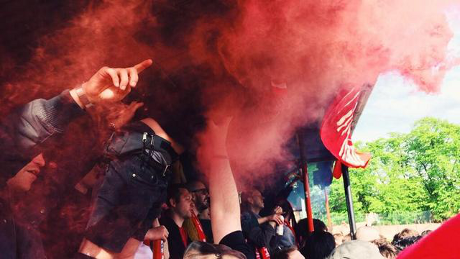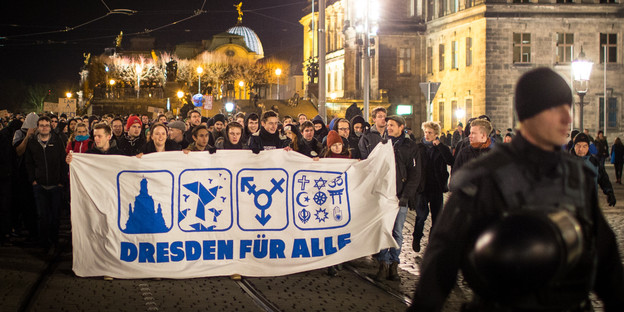Anti-Racism, Working Class Formation And The Significance Of The Racialized Outsider
by Satnam Virdee
The second of a two part essay on race, racism and the making of the English working class.
First published: 21 December, 2014
Part I of this essay highlighted the powerful structuring force of racism in English society over two centuries, including within the English working class. However, throughout the nineteenth and twentieth centuries, there were also periods of multi-ethnic class solidarity when parts of the English working class collectively suppressed expressions of racism and, on occasion, actively rejected it altogether. Central to these moments were socialist men and women belonging to minority groups – Irish Catholic, Jewish, Indian, Caribbean and African – whom I describe as racialized outsiders. It is these men and women against whom the dominant conception of English/ British nationalism was constructed, and whose attachment to such conceptions therefore tended to be weaker, while their participation in subaltern conflicts gave them a unique capacity to see through the fog of blood, soil and belonging and thereby to universalise the militant, yet often particularistic, fights of the working class. Informed by their unique perspective on society, they thus acted as a leavening agent, nourishing the struggles of all.
Such racialized outsiders played a formative role in bringing together concern about racialized oppression with that of class exploitation during the late eighteenth and early nineteenth centuries – the heroic age of the proletariat. For example, the anti-slavery movement was intellectually and politically nourished by the growing population of freed slaves of African descent. While small numbers of Africans had been resident in England since the sixteenth century, this population had grown to between ten and twenty thousand people by the late eighteenth century.[1] It was a freed slave, Olaudah Equiano, who brought firsthand experience of slavery to the attention of the British public. Equiano recounted the story of the slave ship Zong and how in 1781 its captain had thrown 122 sick slaves overboard, with another ten committing suicide in despair. The captain’s motivation was that because the slaves were considered cargo, the ship's owners were entitled to £30 a head compensation for their loss at sea, whereas if the slaves had died on land they would have received no compensation. Equiano’s remarkable autobiography The Interesting Narrative of the Life of Olaudah Equiano (1789) – an account of his suffering as a slave, as well as his subsequent life in Britain – rapidly went through several editions, and, was one of the earliest books promoted by the Committee for the Abolition of the Slave Trade.
And it was Robert Wedderburn – born in Jamaica in 1762 to an enslaved African woman and a Scottish doctor and sugar planter – who helped make visible the links between the suffering and struggles of African enslaved peoples abroad and working class struggles at home.[2] By 1813, Wedderburn appears to have joined the Spencean Philanthropists – a left-wing group inspired by Thomas Spence’s writings. Shortly afterwards, he went on to publish six editions of a magazine called The Axe Laid To The Root. Through this remarkable magazine and countless meetings of the Speancean Philanthropists, he linked the plight of the ‘African slave’ to the difficulties faced by the English working poor for, ‘The means to obtain justice is so expensive, that justice cannot be obtained’.[3] This attempt to conjoin the struggles against slavery with social justice for the working poor found political expression in his calls for a Jubilee – a free and egalitarian community. According to Wedderburn, Spence
…knew that the earth was given to the children of men, making no difference for colour or character, just or unjust; and that any person calling a piece of land his own private property, was a criminal; and though they may sell it, or will it to their children, it is only transferring of that which was first obtained by force or fraud.[4]
Attempts to forge this kind of multi-ethnic working class solidarity became less evident after the catastrophic defeat of Chartism and the consolidation of racist, nationalist and imperialist discourses and practices within the working class. Between 1848 and 1973, the current of proletarian internationalism largely became the preserve of those socialists who were racialized minorities. Apart from some notable exceptions like William Morris, Belfort Bax, Sylvia Pankhurst and John Mclean – it was minority men and women like Eleanor Marx, James Connolly, Zelda Kahan, Theodore Rothstein, Arthur McManus, Shapurji Saklatvala and Claudia Jones who attempted against great odds to challenge racist divisions within the working class. In the course of the new unionism of the 1880s and 1890s, Eleanor Marx, William Morris and other socialist internationalists were able, albeit briefly, to broaden the development of the emergent English-Irish working class solidarity such that it also came to encompass the newly-arrived Jewish migrants. Similarly, in the 1920s and 1930s, racialized minorities within the Communist Party of Great Britain (CPGB) like Shapurji Saklatvala, Arthur McManus and Phil Piratin played important roles in challenging the hold of racist, anti-Semitic and imperialist ideas within the working class, culminating in the solidarity action instigated in support of Arab seafarers in the North-East of England and the defence of the Jewish community in the East End of London.
However, it was in the aftermath of the ‘world revolution of 1968’[5] that significant parts of the English working class finally began to challenge racism. This was a conjuncture shaped on the one hand by decolonisation in Asia, Africa and the Caribbean, the struggle for civil rights in the US, and black resistance at home and, on the other hand, by the organic crisis of British capitalism, the collapsing welfare settlement and the intensification of the class struggle. In that transitional moment in the 1970s – between a welfare state settlement that was in crisis and a neoliberalism that had not yet been named, and whose victory was not assured – Britain experienced an unprecedented wave of social unrest.
Under these changing circumstances, the organised labour movement shifted from its long-standing indifference towards racism, towards actively challenging it - most notably in support of Asian women workers on strike at Grunwick, a film processing plant in north-west London. When Jayaben Desai – along with 137 of her mainly female Asian colleagues – struck against terrible working conditions and managerial racism, solidarity action flowed not only from national trade union leaders but large numbers of rank and file workers. Donations came in from local workers at the ‘Milliner Park Ward, Rolls Royce Works Committee, Express Dairies, Associated Automation (GEC), TGWU, and the UPW Cricklewood Office Branch’.[6] Significantly, on 1 November 1976, the post office workers in the UPW stopped delivering Grunwick’s mail. Ten months on from the start of the dispute, mass picketing began in the week of 13 June 1977 with between 1,000 and 2,000 pickets present. By the end of that week, those numbers had swelled to 3,000, including miners from the coalfields of South Wales and Yorkshire – the latter led by Arthur Scargill.[7] The largest picket occurred on 11 July 1977 when an estimated 18,000 people – among them workers, feminists and anti-racists – joined Desai and the strikers in an unprecedented show of solidarity.[8] Particularly significant was the solidarity action from the London dockers who in 1968 had marched to the Houses of Parliament in support of Enoch Powell’s ‘rivers of blood’ speech shouting ‘Back Britain, not Black Britain’ demanding an end to black immigration. Less than a decade later at Grunwick, amid a rising tide of industrial and political radicalisation, some of those same dockers carried the Royal Docks Shop Stewards’ banner at the head of a mass picket in support of the predominately Asian workforce at Grunwick.
Alongside such anti-racist action in the workplace, parts of organised labour and youth helped fashion anti-racist and anti-fascist social movements of a scale unprecedented in Britain. From Rock Against Racism (RAR) to the Anti-Nazi League (ANL), a new popular politics against racism and fascism was emergent with the socialist left (both within the Labour Party and without) at its centre. The ANL attempted to counterpose its own embryonic vision of the alternative society – one based on love not hate and multi-ethnic solidarity not racial division. This was most clearly visible at the major carnivals it organised alongside RAR throughout 1978 and 1979. The first, held at Victoria Park on 30 April 1978, was a genuinely national gathering with among others more than 40 coaches arriving from Glasgow, a whole train from Manchester, and a further 15 coaches from Sheffield.[9] The march to the carnival site at Victoria Park in East London was led by giant papier maché models of Adolf Hitler and others, built by Peter Fluck and Roger Law – the makers of Spitting Image. At the carnival itself, the Clash, X-Ray Spex, Tom Robinson and Steel Pulse played to 80,000 people. Peter Hain, Vishnu Sharma – of the Indian Workers Association (IWA) – Miriam Karlin and Ray Buckton made speeches against racism and fascism. Raphael Samuel – a key member of the CPGB historians group – described the march to the carnival as one of ‘the most working-class demonstrations I have been on, and one of the very few of my adult lifetime to have sensibly changed the climate of public opinion’.[10]
Significantly, the part played by socialist activists, particularly those of racialized minority descent, was decisive. They proved to be the conduit through which anti-racist ideas, consciousness and political practice – until then, narrowly confined to the minority communities – came to be transmitted to the left-wing of the organised labour movement and beyond. In that moment when class struggles were brought into alignment with those against racism, an uneven but nevertheless significant organic fusion of social forces took place in which to paraphrase Sivanandan,[11] racialized minority workers ‘through a consciousness of their colour…arrive[d] at a consciousness of class’ and in which parts of the white working class ‘in recovering its class instinct…arrive[d] at a consciousness of racial oppression.’
The experiment in municipal anti-racism in radical Labour-run local authorities further extended such anti-racist sentiment within society opening up areas of non-manual local state employment to racialized minorities for the first time. And through black self-organisation and the alliance with the socialist left in trade unions such changes were consolidated throughout much of the public sector and trade union movement. While racism remained a powerful structuring force throughout the 1980s, the outcome of such collective action was the consolidation of a more durable current of anti-racism in British society, one that had been incrementally constructed over the course of the black struggles against racism in the 1960s, the anti-racist and anti-fascist social movements in the 1970s, and which by the 1980s, had become institutionalised in key sectors of the organised labour movement, the public sector and everyday life within the main urban conurbations. Such anti-racism was the legacy bequeathed to English society by the racialized outsiders of Irish Catholic, Jewish, African and Asian descent.
Continues at: http://www.newleftproject.org/index.php ... racialized







